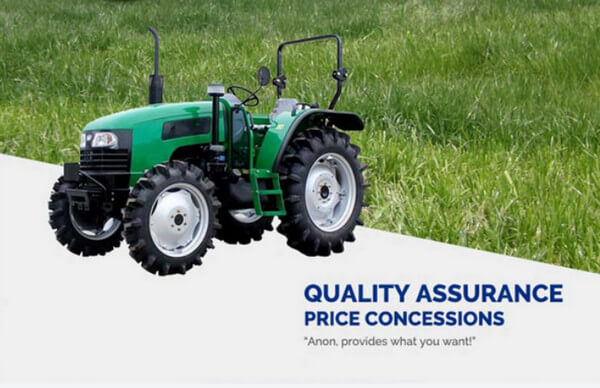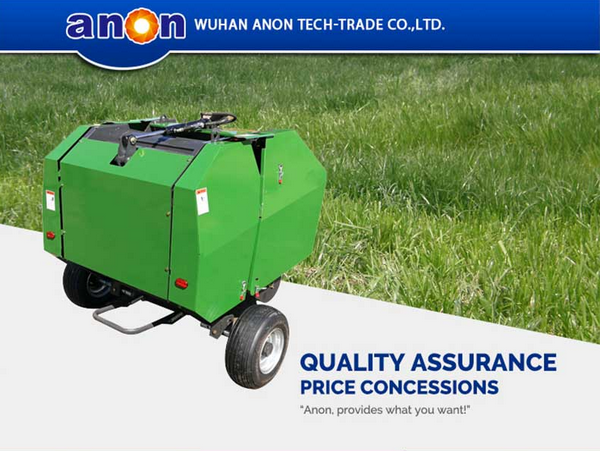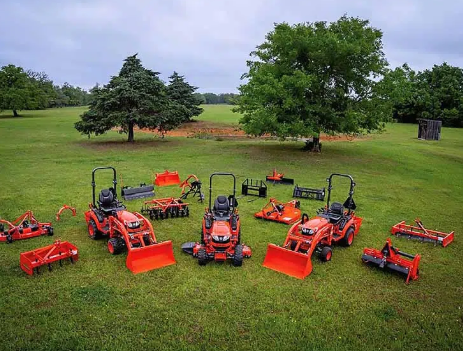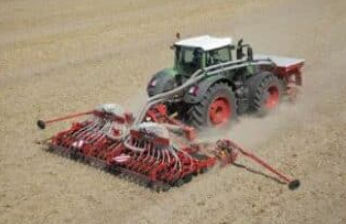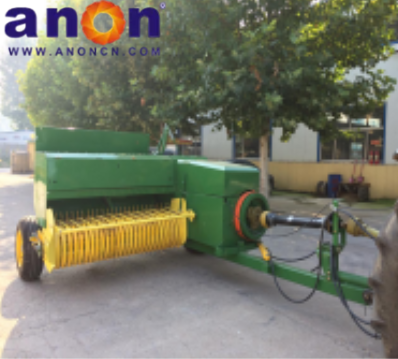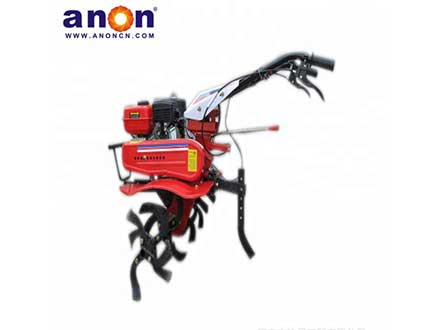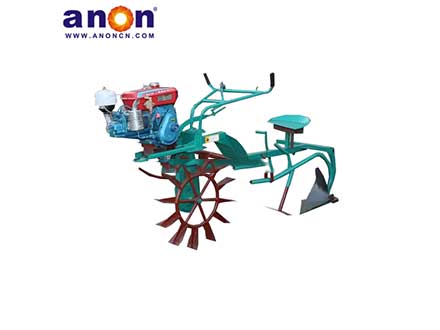Introduction
The most important step in making hay is to spread the grass out to dry properly. But how can you quickly gather large amounts of loose hay? A hay rake will be your best helper. In this article, I will introduce you to several types of hay rakes to help you choose the machine that suits you and improve your work efficiency!
What is a Hay Rake
A hay rake is a type of farming machine, usually either tow-behind or mounted, and it needs to be used with a tractor. The hay rake collects scattered grasses, wheat, corn stalks, and other crop residues, turning them into neat rows. This makes it easier for you to organize the cut hay into a shape that is ready for bundling, transportation, and storage. The purpose of raking is to make the hay fully dry and facilitate the collection of hay.
A hay rake uses mechanical parts like spring teeth, tines, and rollers to lift grass or straw from the ground and form neat windrows. It flips the hay layers so the top and bottom get equal exposure to sunlight and air, helping moisture evaporate faster. This prevents the bottom layer from staying wet too long and reduces the risk of mold. Finally, it gathers the dried hay into rows, making it easier for the baler to collect and greatly improving your work efficiency.
Types of Hay Rake
There are many types of lawn rakes. Next, I will introduce them from the perspective of their structure, working principle, application scenarios and their respective advantages, so that you can effectively understand the differences between these lawn rakes.
Dump Rake
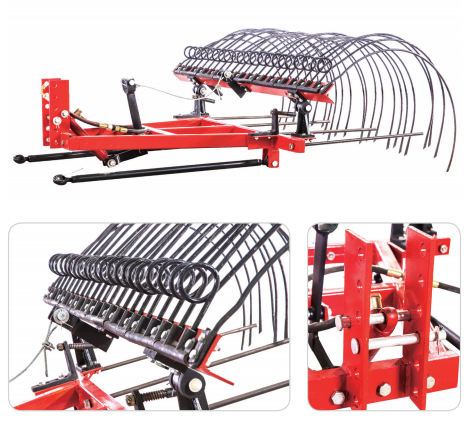
The dump hay rake gets its name because the hay rows it creates run perpendicular to the machine’s direction. Its structure is simple. It mainly consists of a straw rake, a lifting mechanism, and a frame. The rake features a row of horizontally parallel teeth. These teeth can be circular or spiral-shaped. The shape of the teeth affects the rake’s effectiveness and quality in collecting grass strips. The spacing between the teeth usually ranges from 7 to 9 millimeters. Smaller spacing helps grass strips stack more compactly. Larger spacing is suitable for thicker grass.
Working principle
When the dump hay rake moves forward, the spring teeth lift the grass from the bottom along its curved surface, raising it to the highest point before it falls down to form a hay row. Once the row fills the front part of the teeth, the lifting system can raise the rake. Then, using the weed bar, the gathered hay is dropped to the ground, forming a hay row about the same length as the working width of the rake. After that, the rake automatically lowers and continues gathering hay.
Application
The dump hay rake works at a slower speed, usually 4 to 5 kilometers per hour. Unlike the wheel-type rake, you can adjust the size of the hay rows it creates. If your field is small or the grass yield is not very high, a dump hay rake will be enough for your needs.
Advantages
Diverse structures and strong adaptability
The drum hay rake has multiple structural types, including three-point suspension and traction, which can meet the needs of different farms or grasslands. The three-point suspension type is suitable for small farms, while the traction type can increase the distance of a single grass sweep, helping you improve work efficiency.
Flexible operation and easy control
When the drum hay rake is in operation, its teeth touch the ground and can integrate the grass cut by the lawn mower into horizontal grass strips. This size can be manually controlled, making it convenient for herdsmen to adjust according to their actual needs.
Wheel Rake
The wheel rake, also known as the finger-disk hay rake, is made up of several finger disks. Each disk has multiple flexible raking teeth that are used to gather the hay. You can adjust the width of the hay row by changing the angle of the disks. The raking teeth are usually arranged at a certain angle and are mounted on the frame axle, allowing them to rotate freely. There are two types of raking: single-sided and double-sided. The rake doesn’t have a complex drive system. Instead, it relies on the friction between the ground and the wheels to make the disks rotate and complete the work. This makes the wheel-type hay rake simple in design and easy to maintain.
Working principle
When the tractor pulls the wheel-type hay rake forward, the raking wheels roll along the ground, making the rake rotate and gathering the grass or straw to one side. Through continuous raking, the wheel-type hay rake can create neat rows of hay on the ground. The angle between the plane of the raking wheels and the direction of the machine’s movement is usually 135 degrees. You can also use the wheel-type hay rake to flip the hay. To do this, you simply need to change the angle between the raking wheels’ plane and the direction the machine is moving.
Application
The wheel-type hay rake can work at speeds of over 15 kilometers per hour. If you need to handle a large amount of grass, this type of rake is a good choice. Its flexible raking teeth can also gather leftover crop residues and plastic film from the soil, helping to reduce plastic pollution on the land.
Advantages
1. Affordable
The wheel rake is currently the most affordable rake on the market, with a simple structure that only requires a small amount of adjustment to operate normally. The operation is simple and convenient, and the ground drive simplifies the operation and reduces costs. Because the wheeled rake does not rely on belts, gears, or motorization, it is easier to maintain and upkeep.
2. Good wedding effect
The wheel rake operates smoothly through the rotation of the finger wheel and the movement of the teeth, reducing the loss of grass leaves during transportation. Effectively gather the grass on the ground, and the gathered grass should be loose and even, which is beneficial for subsequent drying and bundling.
Rotary Rake
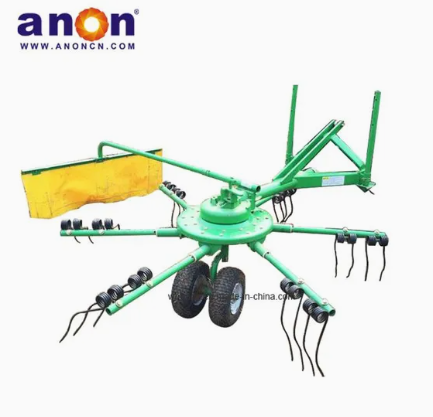
You can divide the rotary hay rake into two types based on its components: the rake type and the spring-tooth type. The rotary hay rake has 6 to 8 rakes on each rotating part, while the spring-tooth type has several spring teeth around the rotating parts.
A rotary hay rake mainly consists of the frame, drive system, rotating body, wheels, rear deflector, and raking parts (either spring teeth or rakes).
The wheels support the machine and help it move on the ground, making it easier to operate. You can adjust the rear deflector to change the working width based on the amount of grass. The raking parts on the rake arms work with the deflector to gather the grass and straw.
Working principle
As the tractor moves forward, the ground wheels also move, and the hay rake begins to work. The rake teeth rotate around a central axis while also spinning on their own. The cam track and cam cover limit the teeth, making them rotate along a fixed path and angle. This design makes sure the rake teeth accurately gather the hay in a specific spot and can also flip the hay.
The working principle of the rotary hay rake is simple. When the rotating parts spin, centrifugal force makes the spring teeth open, performing the raking action. To spread the hay, you need to change the angle at which you install the spring teeth.
Application
The rotary hay rake works quickly, with speeds of 12 to 18 kilometers per hour. It gathers the hay into loose, airy rows, which helps the grass dry thoroughly and shortens the drying time, resulting in higher-quality hay bales. If you have a large field with a high yield, a rotary hay rake would be a good choice.
Advantages
1. Shorten drying time
The rotary hay rake can shorten the drying time by loosening and flipping the hay during operation, separate the hay, prevent moisture accumulation and mold growth, and proper ventilation is crucial for high-quality crops.
2. More efficient
The rotary hay rake collects hay faster and can cover a larger field area in a shorter amount of time, saving manpower and increasing efficiency.
Drum Rake
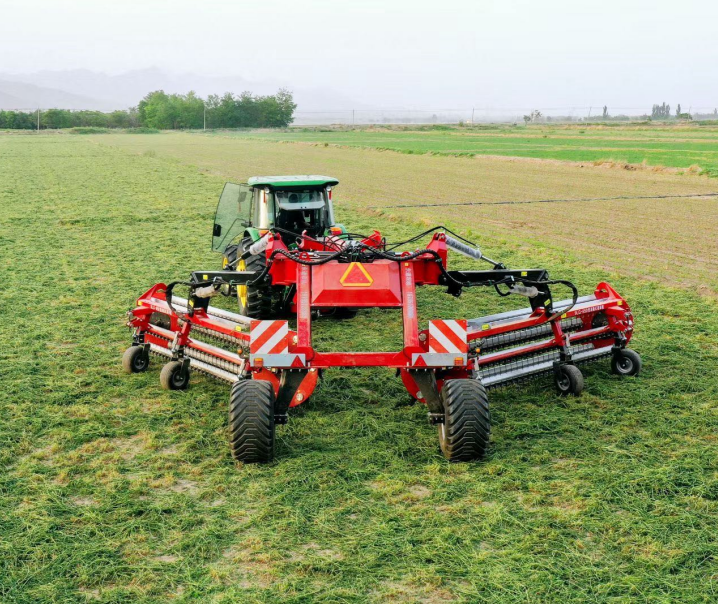
The main working component of a drum hay rake is a rake drum that rotates around a horizontal axis. The drum is composed of 3 to 6 parallel toothed rods with rows of rake teeth. The two ends of the toothed rods are connected to two parallel ones on the circular plane of the drum, forming a parallelogram structure. Therefore, during the rotation of the drum, the direction of the teeth always remains parallel to each other.
Working principle
When the drum hay rake works, the tractor’s power take-off shaft will drive the drum and then the drum starts rotating. As the machine moves forward, the raking spring teeth also rotate around a horizontal axis. When the grass and straw come into contact with the spring teeth, they form continuous hay rows between the two drums, aligned with the direction the machine is moving.
Application
The drum hay rake can work at speeds of 12 to 18 kilometers per hour. The dense spring teeth on the two drums effectively gather the dry hay and reduce waste. As the drums rotate, the spring teeth move in a sweeping motion, keeping the hay rows loose and airy. If you have a large field with a high yield and need high-quality hay rows, the cylinder hay rake would be a good choice.
Advantages
1. Strong versatility
The drum rake can complete multiple operations of field hay preparation, such as raking, spreading, and turning hay. By adjusting the speed, inclination, and direction of the drum, it shows strong versatility.
2. Small loss of hay
Since the spring teeth of the drum rake do not touch the ground during the raking process, the grass is not easily contaminated, and the loss of hay is small, which can maintain the excellent quality of hay and reduce waste during the harvesting process.
Factors to Consider When Choosing a Hay Rake
Consider Land Area
First, choose a hay rake with a suitable working width based on the size of the area you need to rake. For large-scale operations, select a model with a wider working width and higher efficiency.
Consider Pasture Type
Next, consider the type of pasture, such as natural or cultivated grasslands, and the type of forage, like high-yield or low-yield grasses. Choose a hay rake that matches your pasture. Side-delivery rakes are better for high-yield fields, while wheel rakes work well in low-yield areas.
Consider Budget and Costs
Finally, take your budget into account. Choose a model and configuration that fits your financial plan. Also consider long-term costs, such as fuel consumption and maintenance expenses.
Maintenance Tips for Hay Rakes
Regular Inspection and Cleaning
After each operation, clean off grass clippings, dirt, and debris from the hay rake, especially key parts like spring teeth, tines, and rollers, to prevent clogging and wear.
Check all fasteners—such as bolts and nuts—for looseness. Inspect drive parts like chains and belts for wear or breakage. If belts are worn, cracked, or slipping, replace them promptly to maintain transmission efficiency.
Lubrication and Maintenance
Lubricate bearings, chains, gears, and other moving parts regularly according to the user manual to reduce friction and wear. Always use proper lubricants—avoid poor-quality or incorrect products.
Long-Term Storage Maintenance
If the rake won’t be used for an extended period, clean it thoroughly to remove all dirt and debris. Apply rust protection to metal parts using anti-rust oil or paint. Store the machine in a dry, ventilated, and shaded place to avoid moisture and direct sunlight.
Even during storage, check the machine regularly and run it occasionally to prevent damage from long-term inactivity.
Conclusion
After my introduction, do you now understand the differences between the different types of hay rakes? There is no “best” hay rake, only the one that is best for you. If you are looking to buy a hay rake, feel free to contact us at ANON. We can analyze your needs and recommend the best hay rake for you!
FAQ
Is raking hay necessary?
In the process of making hay, there are a few harvest management tactics that can greatly affect forage quality at feeding. The raking process can be the most critical to identify and conduct proper management practices to help conserve the available nutrients in the crop and reduce crop losses.
What is the difference between a hay tedder and a hay rake?
You can use the hay tedder to spread and dry grass or straw, while the main function of the rake is to gather hay for subsequent bundling, transportation, and storage.


